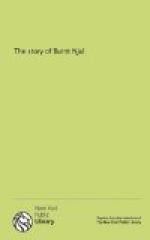The present reprint has been prepared in order that this incomparable Saga may become accessible to those readers with whom a good story is the first consideration and its bearing upon a nation’s history a secondary one—or is not considered at all. For Burnt Njal may be approached either as a historical document, or as a pure narrative of elemental natures, of strong passions; and of heroic feats of strength. Some of the best fighting in literature is to be found between its covers. Sir George Dasent’s version in its capacity as a learned work for the study has had nearly forty years of life; it is now offered afresh simply as a brave story for men who have been boys and for boys who are going to be men.
We lay down the book at the end having added to our store of good memories the record of great deeds and great hearts, and to our gallery of heroes strong and admirable men worthy to stand beside the strong and admirable men of the Iliad—Gunnar of Lithend and Skarphedinn, Njal and Kari, Helgi and Kolskegg, beside Telamonian Aias and Patroclus, Achilles and Hector, Ulysses and Idomeneus. In two respects these Icelanders win more of our sympathy than the Greeks and Trojans; for they, like ourselves, are of Northern blood, and in their mighty strivings are unassisted by the gods.
In the present volume Sir George Dasent’s preface has been shortened, and his introduction, which everyone who is interested in old Icelandic life and history should make a point of reading in the original edition, has been considerably abridged. The three appendices, treating of the Vikings, Queen Gunnhillda, and money and currency in the tenth century, have been also exised, and with them the index. There remains the Saga itself (not a word of Sir George Dasent’s simple, forcible, clean prose having been touched), with sufficient introductory matter to assist the reader to its fuller appreciation.
Sir George Webbe Dasent, D.C.L., the translator of the Njals Saga, was born in 1817 at St. Vincent in the West Indies, of which island his father was Attorney-General. He was educated at Westminster School, and at Magdalen Hall, Oxford, where he was distinguished both as a fine athlete and a good classic, He took his degree in 1840, and on coming to London showed an early tendency towards literature and literary society. The Sterlings were connected with the island of’ St. Vincent, and as Dasent and John Sterling became close friends, he was a constant guest at Captain Sterlings house in Knightsbridge, which was frequented by many who afterwards rose to eminence in the world of letters, including Carlyle, to whom Dasent dedicated his first book, Dasent’s appointment in 1842 as private secretary to Sir James Cartwright, the British Envoy to the court of Sweden, took him to Stockholm, where under the advice of Jacob Grimm, whom he had met in Denmark, he began that study of Scandinavian literature which has enriched English




